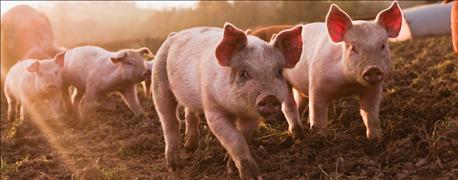June 1, 2016

Pork profit prospects have faded. It never looked like a “golden” year, but at the end of the winter, the profit outlook was for positive returns of about $6 per head. Those are not big numbers, but they would have paid all bills and left a little extra for the family.
Then, feed prices went on an upward rampage. Maybe “rampage” is too strong a word for corn that increased about 40 cents per bushel after April 1. Nevertheless, rampage is probably not too strong of a word for the upward surge in soybean meal prices of over $100 per ton. Corn prices rose about 11%, while meal was up 40%.

PORK PROFIT POTENTIAL FADES: These hogs may be more expensive to feed this summer than originally thought. The increased cost could erode pork profit potential. (Photo: Jupiterimages/BananaStock/Thinkstock)
It’s easy to find reasons why. Late growing-season weather turned harmful in South America, and corn and soybean production were cut. The U.S. dollar weakened in the first quarter and stimulated U.S. exports of corn and soybeans. Then the USDA provided its first updates for the 2016-17 marketing year and said that world soybean inventories would be the tightest in eight years. Finally, some meteorologist suggested La Niña might arrive by midsummer, bringing increased changes of heat and dryness for major corn and soybean production areas.
Weather impacts pork profits
The weather is now very important to profit prospects. Corn and soybean yields tend to be determined in July and August, and even early September for soybeans. Weather in coming weeks will be a large determinant of feed costs for the next year.
Feed prices may be higher in the early portion of the growing season and lower in the latter portion of the growing season. Weather uncertainty early in the growing season may result in feed prices being higher, as a “weather premium” is built into price. Once there is more yield certainty, the weather premium tends to be reduced.
The visual shows this pattern with average cash corn prices in central Indiana over the past 10 crop years. The highest average prices were in June and early July. Roughly after the July 4 holiday, corn prices started to move lower as yields became more certain.
Lower corn prices in late July and August are the tendency. However, in roughly one out of six years, a weather event causes prices to move higher into the late growing season. The most common weather event is drought.
In 2015, I estimated farrow-to-finish producers operated at a loss of $3 per head. My earlier 2016 estimates for a $6-per-head profit have now been erased by higher feed prices. Current estimates are for losses of about $5 per head for the entire year.
This summer’s weather is going to have a lot to say about the level of profits, or losses, for the coming year.
Hurt is a Purdue University Extension ag economist. He writes from West Lafayette, Ind.
.jpg?width=600&auto=webp&quality=80&disable=upscale)
You May Also Like




